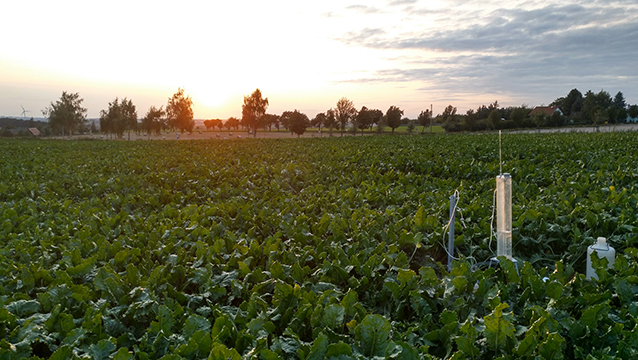Ploughing, Mulching, or Direct Sowing: Modelling of Soil Structural Changes as Important Fundamental Research
World Environment Day on 5 June: United Nations University (UNU-FLORES) and TU Dresden work together for sustainable resource management
World Environment Day on 5 June: United Nations University (UNU-FLORES) and TU Dresden work together for sustainable resource management
Since 1972, most countries in the world have been celebrating the United Nations World Environment Day on 5 June. In the past decades, environmental awareness has risen. More and more people realise how vulnerable the natural resources that we all depend on are. Yet, the situation is worsening and global efforts for protecting the environment are in dire need.
With the United Nations University Institute for Integrated Management of Material Fluxes and of Resources (UNU-FLORES), the United Nations University has established a research institute in Dresden that deals with the management of environmental resources such as water, soil, and waste. In the centre of it all is the Nexus Approach, which looks at the complex interdependencies of resources in an integrated manner. To advance this, UNU-FLORES is closely cooperating with TU Dresden. Together with the Faculty of Environmental Sciences, UNU-FLORES offers a Joint PhD Programme. It trains a new and international generation of scientists, engineers, and managers that dedicate their work to sustainable management of resources and help advocate for the approach worldwide.
Two of the PhD researchers are Parvathy Chandrasekhar and Janis Kreiselmeier. They were both supervised by Prof. Karl-Heinz Feger of the Institute of Soil Science and Site Ecology of TU Dresden and Dr Kai Schwärzel (now Thünen Institute of Forest Ecosystems) of UNU-FLORES. In the frame of a project funded by the German Research Foundation (DFG), they looked at how soil structure is affected by agricultural management and how this might change the soil’s ability to store and transmit water. The aim was to simulate observed changes and help improve hydrological models.
Parvathy Chandrasekhar used an existing model and adapted it to several case studies found in published research articles. Hydrological models can be an important basis for measures in agriculture and forestry as well as in environmental and land-use management. They help us understand and predict how much water evaporates, is stored, or runs off on the surface. So far, changes in soil structure due to, for example, tillage in agriculture, have rarely been considered, even though they may change water movement in the soil drastically.
From late 2015 to 2018, Janis Kreiselmeier periodically did field experiments and sampled soil on an experimental site in the Loess Hilly Region of Saxony (Lommatzscher Pflege). The samples were analysed in the commonly used Nexus-Laboratory of TU Dresden and UNU-FLORES in Tharandt. Soil at the experimental site was subject to three different treatments. Before sowing of the crop, it was either tilled conventionally with a moldboard plough, in a reduced version with a harrow, or not tilled at all. Whether it has been tilled or otherwise, weather events such as rainfall and frost, soil biota, and gravity contribute to changes in soil structure. The field without any tillage showed little to no changes in the soil structure over time. Water retention was improved here due to a finer developed pore space compared to the other two treatments. Tilled soil, on the other hand, clearly changed its structure over the course of a growing season. The differences between conventional tillage and reduced tillage were minor. Initially, the mechanical loosening of the soil improved the soil structure and, hence, water movement. But these benefits were shortlived and were mostly lost throughout the growing season.
Thus far, modelling soil structural changes have shown, that simple processes such as the initial setting of the soil post-tillage can well be described. However, the complex interplay of human influence and environmental factors leave room for improvements of such models.
Further information on the DFG-funded project “Development of Models to Predict Land-Use-Induced Soil Pore-Space Changes and their Hydrological Impacts (SoilPoreDyn)”: https://flores.unu.edu/en/research/projects/development-of-models-to-predict-land-use-induced-soil-pore-space-changes-and-their-hydrological-impacts.html
Institute of Soil Science and Site Ecology, TU Dresden: https://tu-dresden.de/bu/umwelt/forst/boden
Information on the Joint PhD Programme of TU Dresden/Faculty for Environmental Sciences and UNU-FLORES: https://flores.unu.edu/en/education/phd-programme/phd-programme-in-integrated-management-of-water-soil-and-waste.html
Press release distributed by Pressat on behalf of United Nations University-FLORES, on Saturday 6 June, 2020. For more information subscribe and follow https://pressat.co.uk/
Soil Science Environment Nature Science Environmental Management Environment & Nature
Published By

comma_flores@unu.edu
https://flores.unu.edu/en/
Atiqah Fairuz Salleh
Communications & Advocacy
b.m.salleh@unu.edu
+49 351 8921 9387
Visit Newsroom
You just read:
Ploughing, Mulching, or Direct Sowing: Modelling of Soil Structural Changes as Important Fundamental Research
News from this source:


